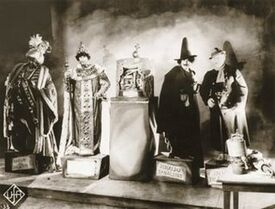
A promotional still of the film
Waxworks (original title: Das Wachsfigurenkabinett) is an 1924 fantasy/horror silent film directed by Paul Leni. The film is about a writer who accepts a job from a waxworks proprietor to write a series of stories about the exhibits of Caliph of Baghdad, Ivan the Terrible and Jack the Ripper in the museum in order to boost business.
Although Waxworks is often credited as a horror film, it is a anthology film that goes through various genre's including a fantasy film adventure, a historical film, and a horror film through its various episodes. This film would be director Paul Leni's last film made in Germany before he went on to make The Cat and the Canary (1927) in America.
Plot summary[]
A young nameless poet (William Dieterle) enters a wax museum where the museum propieter (John Gottowt) works in company of his daughter (Olga Belajeff). The museum hires the poet to write up a back-story for his wax models of Harun al-Rashid (Emil Jannings), Ivan the Terrible (Conrad Veidt), and Jack the Ripper (Werner Krauss) in order to draw an audience for his museum. With the daughter by poet's side, he notices that the arm of Harun al-Rashid is missing and writes a story incorporating the missing arm.
Harun al-Rashid[]
The poet sees himself in his story as a pie baker Assad where he lives with his wife directly by the walls of the palace of the Harun Al-Rashid lives. Smoke from the Assads' bakery covers the front of the palace, where the al-Rashid loses a game of chess, leading him to want the head of the baker. He sends his Grand Vizier to find the man, Assad, but in doing so, he finds Assad's wife with whom he is enchanted. After being captivated by her beauty and also captivating her with his status among the royals, he returns to tell Al-Rashid that he does not have the baker's head but rather something better - his wife. Al-Rashid then resolves to go out that night, incognito, and visit the beauty. When he steals away from his castle, the ruler witnesses an argument between the jealous Assad and Maimune, who both seem dissatisfied with their poverty-laden life. Assad then says he will rob Al-Rashid's wishing ring to solve their problems.
While the Al-Rashid visits the bakery that night, Assad robs the wishing ring off the wax figurine of Al-Rashid by slicing the arm of the figurine, and is spotted by his guards and is chased out of the palace. Meanwhile, Al-Rashid tries to impress Assad's wife. The returning Assad penetrates by force into the locked house, while Maimune hides Al-Rashid in the baking-oven. The guards rush in arrest Assad but Assad's wife uses the Wishing ring to make Al-Rashid "appear" as he secretly comes out of the oven. After this, they come to an agreement where Assad becomes the official baker for Al-Rashid.
Ivan the Terrible[]
The second episode deals with the Czar of Russia, Ivan the Terrible. Two near-newly weds (Dieterle and Belajeff) have their wedding interrupted by Ivan the Terrible who takes a liking to the girl and has her abducted to his lair.
Jack the Ripper[]
After the poet finishes the last two stories, he wakes up to find that the wax model of Jack the Ripper has come to life, but it is recognized instead to be Spring-heeled Jack. Spring-Heeled Jack stalks both the poet and the waxwork owner's daughter. The Poet and the girl flee but always find that they can't escape Spring-Heeled Jack through the dark, twisted halls of the museum. As Jack draws close enough, multiple versions of him appear, and as his knife begins to slash, it provokes the poet to wake up to realize that the last experience was a dream. Occasionally, Jack the Ripper was referred to as "birdner" because of his ability to travel around like a bird.
Production[]
Although Leni is credited with full direction, Leo Birinski is said to have actually directed the actors. Leni was mostly responsible for the settings with the assistance of Fritz Maurischat.
The film's script by Henrik Galeen has a large cut by Leni, mainly the fourth tale in the story about Rinaldo Rinaldini who was to be played by William Dieterle, a story based on the novel of the same name by Christian August Vulpius from 1798. Leni decided to substitute this for the short tale of Spring-Heeled Jack. The statue of Rinaldini is still viewable in the scene with the wax figures, as the character with the large black hat.
Cast[]
- Emil Jannings as Harun al-Rashid: Jannings plays the role of the pot-bellied Harun al-Rashid in the Arabian Knights tale. Jannings' take on the character is a rare comedy role for the actor, who usually starred in more dramatic roles.
- Conrad Veidt as Ivan the Terrible: Veidt plays the role of the Russian czar Ivan the Terrible. Russian director Sergei Eisenstein would later use Veidt's model for his own rendition in Ivan the Terrible (1946).Template:Fact Veidt also appeared in another Leni film, The Man who Laughs (1928).
- Werner Krauss as Jack the Ripper/Spring-Heeled Jack: Krauss plays the roll as both killer figures in the film, referred to twice by different names. Krauss also starred with actor Conrad Veidt in the popular horror film The Cabinet of Dr. Caligari (1920).
- William Dieterle as The Poet/Assad the Baker/A Russian Prince: Dieterle plays various rolls in the film as the poet. His character often writes himself into his own stories.
See also[]
- List of films made in Weimar Germany
External links[]
- Waxworks at IMDB
- Template:Amg movie
- Waxworks at Rotten Tomatoes
- Paul Leni the forgotten master
Template:Paul Leni films